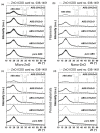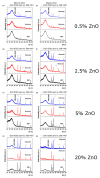3D Printed Metal Oxide-Polymer Composite Materials for Antifouling Applications
- PMID: 35335730
- PMCID: PMC8949573
- DOI: 10.3390/nano12060917
3D Printed Metal Oxide-Polymer Composite Materials for Antifouling Applications
Abstract
Current technology to prevent biofouling usually relies on the use of toxic, biocide-containing materials, which can become a serious threat to marine ecosystems, affecting both targeted and nontargeted organisms. Therefore, the development of broad-spectrum, less toxic antifouling materials is a challenge for researchers; such materials would be quite important in applications like aquaculture. In this respect, surface chemistry, physical properties, durability and attachment scheme can play a vital role in the performance of the materials. In this work, acrylonitrile butadiene styrene (ABS)/micro ZnO or nano ZnO composite lattices with different metal oxide contents were developed using 3D printing. Their antifouling behavior was examined with respect to aquaculture applications by monitoring growth on them of the diatoms Navicula sp. and the monocellular algae Chlorella sp. with image analysis techniques. As shown, the presence of metal oxides in the composite materials can bring about antifouling ability at particular concentrations. The present study showed promising results, but further improvements are needed.
Keywords: 3D printing; ZnO based ABS composites; antifouling properties; aquaculture.
Conflict of interest statement
The authors declare no conflict of interest.
Figures
















References
-
- Food and Agriculture Organization of the United States . The State of World Fisheries and Aquaculture 2020. In Brief. Food and Agriculture Organization of the United States; Rome, Italy: 2020. The State of World Fisheries and Aquaculture. - DOI
-
- García-Bueno N., Marín A. Ecological management of biomass and metal bioaccumulation in fish-cage nettings: Influence of antifouling paint and fiber manufacture. Aquaculture. 2021;544:737142. doi: 10.1016/j.aquaculture.2021.737142. - DOI
-
- Yebra D.M., Kiil S., Dam-Johansen K. Antifouling Technology-Past, Present and Future Steps towards Efficient and Environmentally Friendly Antifouling Coatings. Prog. Org. Coat. 2004;50:75–104. doi: 10.1016/j.porgcoat.2003.06.001. - DOI
-
- Bloecher N., Floerl O. Efficacy testing of novel antifouling coatings for pen nets in aquaculture: How good are alternatives to traditional copper coatings? Aquaculture. 2020;519:734936. doi: 10.1016/j.aquaculture.2020.734936. - DOI
-
- Duarte C.M., Holmer M., Olsen Y., Soto D., Marbà N., Guiu J., Black K., Karakassis I. Will the Oceans Help Feed Humanity? BioScience. 2009;59:967–976. doi: 10.1525/bio.2009.59.11.8. - DOI
LinkOut - more resources
Full Text Sources
Research Materials

